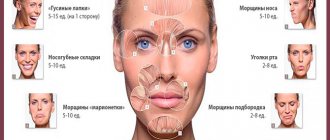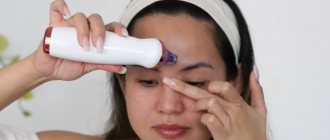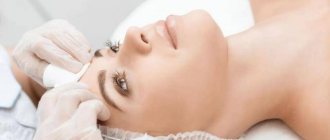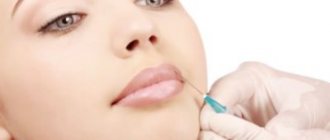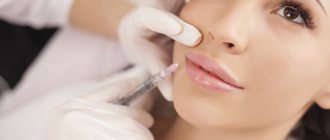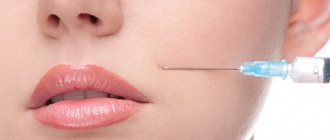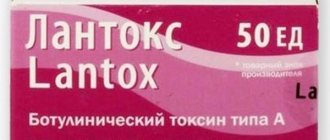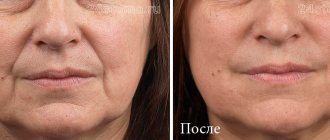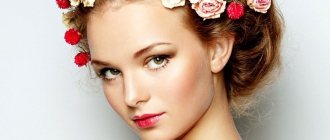What not to do after Botox
Botox injection is one of the world's most famous methods of non-surgical skin rejuvenation, which modern cosmetology successfully uses to solve various problems associated with aging skin of the face and body.
Botox injection is the most famous method of non-surgical skin rejuvenation
https://www.youtube.com/watch?v=JMMxDT3L7AU
Injections of botulinum toxins effectively block the transmission of electrical impulses from nerve to muscle, thereby relaxing pathologically tense muscles and helping to smooth out almost any facial muscle.
Facial Botox effectively fights expression wrinkles and also helps to correct the shape of the face and the volume of the lips.
Botox, like any cosmetic procedure, has its contraindications.
You can inject Botox for wrinkles up to 4 times a year. The duration of the effect ranges from 2 to 6 months, depending on many factors. Even if the result did not last long, the procedure can be repeated no earlier than after 3 months. This is because Botox may stop working if injected frequently. As the intervals shorten, the body's resistance to botulinum toxin increases.
The effect of the injection will vary for different people. It depends on your lifestyle. Bad habits, increased emotionality, poor diet, prolonged exposure to the beach in the sun and heavy physical activity accelerate the removal of Botox. The frequency of injections also depends on age - in youth the effect lasts longer. The duration of the result is also affected by the duration of use of beauty injections - it is believed that botulinum toxin has a cumulative effect.
With regular injection of botulinum, the facial muscles get used to a relaxed state, so the result after each repeated injection lasts longer. It is impossible to predict which factor will affect the duration of the procedure, but experts agree that repeated botulinum toxin injections should be carried out no earlier than three months later. The more often the course is repeated, the higher the likelihood of developing adverse reactions.
Wrinkle correction with Botox injections is performed on an outpatient basis. The cosmetologist, in the presence of the patient, opens the injection solution, draws it into a syringe, then injects the required dose with an insulin needle into selected points on the face. If the procedure is performed for the first time, the specialist administers the minimum recommended dosage of the drug. Since the injections are painless, the area where botulinum toxin is injected is not numbed.
If necessary or at the request of the patient, the doctor uses local anesthetic drugs in the form of a cream or gel. After applying anesthetics, the cosmetologist maintains an interval of 20-40 minutes for them to take effect. Before injections, the facial skin is disinfected with an alcohol antiseptic and time is given to dry.
After removing the needle, the cosmetologist can apply pressure to the injection sites to reduce the likelihood of hematomas. After the planned areas are chipped, the facial skin is wiped with an antiseptic, then a cold compress is applied to the affected areas to reduce the possible development of hematomas and avoid swelling. Upon completion of the procedure, you can immediately return to your normal daily routine, but adhere to minor restrictions.
To achieve the longest possible effect after botulinum toxin injections, you should follow some rules. For the first 4 hours after administration of the drug, you should not lie down or tilt your head - you must maintain an upright position. This is due to the fact that the muscles relax under the influence of the toxin and can take an incorrect position.
It is not advisable to touch the injection sites with your hands, massage or apply cosmetics. These actions can cause infection and inflammation. All sports and active physical activity are prohibited for 48 hours. Even leisurely yoga is prohibited - the muscles must remain calm. In the next 2 weeks, you cannot visit baths and saunas, undergo massage and sun exposure, or go to the solarium. Any thermal influence, even drying hair with a hairdryer, accelerates the removal of botulinum toxin from the body.
We suggest you read: Abdominal exercises in the gym for girls
Swelling can also reduce the effect of the substance, so for the first couple of weeks it is advisable to exclude smoked, salty foods and large amounts of liquid from the menu. As for drinking alcohol, it is generally strictly prohibited for 10-14 days. Alcohol-containing drinks dilate blood vessels, causing Botox to be absorbed into the blood. This is already a dangerous situation for health, in which the likelihood of complications is high.
Despite the safe doses used for the procedure, little preparation is recommended to minimize the likelihood of side effects and achieve a better cosmetic result.
So, what not to do before Botox:
- Take medications that affect the rheological properties of blood. These can be antiplatelet agents, anticoagulants or, conversely, hemostatic agents. If you ignore the recommendation, you may experience bleeding from the injection area or the formation of a blood clot (especially if the cosmetologist does not know the technique of administering the substance and does not have enough knowledge about where Botox can be injected and where it absolutely cannot).
- Eat a lot of salty, spicy foods, drink a lot of water, drink alcohol. This can provoke fluid retention in the intercellular space, swelling and, as a result, a longer rehabilitation period.
- Carry out peelings, scrubs, laser resurfacing and other aggressive cosmetic procedures that increase the sensitivity of the epidermis and require some time for recovery. If there are infectious processes in the treated area, or the integrity of the epidermis is compromised, it is necessary to wait for a more favorable period for injections.
After the procedure, a number of restrictions must also be observed.
What else should not be done after Botox injections in the area between the eyebrows, around the eyes and forehead:
- Bend over, play sports, wash your hair during the first 24 hours. The substance should be distributed in the injection area, and lying down, bending, and active physical activity can lead to increased blood circulation, displacement of Botox into adjacent tissues and immobilization of the latter. That. the risk of distortion of facial features and unsatisfactory aesthetic results increases.
- Do peelings, scrub the skin and carry out other deep cleansing procedures. This recommendation should be followed in the first 1-2 weeks so as not to provoke tissue swelling and migration of the active substance into nearby muscles.
- Stay in the sun for a long time, carry out hot water procedures (sauna, bath), wash with warm water. Heat provokes vasodilation, as a result, blood actively flows into the injection area, which causes swelling.
- Eating salty spicy foods and drinking alcoholic beverages. This is a general recommendation for the pre- and post-procedure period to help reduce the risk of swelling.
- Take medications without a doctor's prescription. Some drugs can enhance or weaken the cosmetic effect of the toxin in tissues. It is highly not recommended to combine the procedure with the subsequent use of certain antibiotics (their action is aimed at destroying or weakening pathogenic bacterial microflora, which means their use will negate the cosmetic result of expensive injections), as well as with medications that affect blood clotting (bruises and hematomas are possible) . You need to discuss all these points with a dermatologist or therapist if there is a need to take the above medications.
During the first 24 hours, there is no need to have any effect on the epidermis. Further gentle care is allowed using light, quickly absorbed moisturizing creams, cooling, and anesthetics. Check with your cosmetologist for a list of medications for the post-procedure period.
After about 2-3 weeks, the epidermis will recover, you can carry out light cleansing procedures, depilation, and facial massage.
During the entire period of action of botulinum toxin, you need to use sunscreen when going outside during the day, especially if the procedure was carried out in the summer or spring.
After a month, you can return to care using exfoliating masks and a soft scrub.
Always remember that each body is individual and the reaction to the same procedure may be different. So don't be alarmed if you notice some side effects. What is considered a normal option:
- pain, hypoesthesia (reduced sensitivity), paresthesia (burning, tingling);
- inflammation, redness, hyperemia;
- ecchymosis (hemorrhages, bruises);
- hematomas.
Not only external symptoms can bother the patient. The procedure involves introducing a bacterial toxin into the tissue. The human body perceives it as a foreign agent and can give a pronounced immune response:
- Allergic reactions (problems with swallowing, rashes, hives).
- Headache.
- Symptoms of a cold, viral disease.
- Digestive disorder.
- Asthenia, fatigue.
- Hyperhidrosis.
Botox for hair is a restorative and healing procedure for strands. It is carried out not with the use of botulinum toxin, but with completely different substances (elastin, keratin, vitamins, amino acids, hyaluronic acid and much more - the composition depends on the specific drug).
We suggest you read: How to remove wrinkles around the eyes
How it works
Botulinum toxin injections are made into the muscles that need to be reduced in activity. Some time after the drug reaches its destination, muscle sensitivity to nerve impulses is blocked. This process leads to skin tightening and wrinkle smoothing. The effect of Botox is temporary – from 3 to 6 months. The drug does not completely paralyze facial expressions, but only relieves muscle hypertonicity.
You should not expect an immediate reaction after botulinum therapy. In rare cases, the effect becomes visible within the first 24 hours after the session. Only after a week can you notice the effect of botulinum, and it begins to work fully 10-14 days after the procedure. The toxin is removed from the body through natural metabolic processes.
Doctors recommend beauty injections at the age of 30-50 years. During this period, expression lines become pronounced, but the epidermis does not yet lose its elasticity. After 50 years, for some people, Botox is no longer effective in solving appearance problems, so in adulthood it is sometimes more rational to use other, more radical rejuvenation methods. In what cases are Botox injections indicated:
- vertical fold between the eyebrows;
- horizontal forehead wrinkles;
- nasolabial folds (pronounced);
- wrinkles around the eyes (“crow’s feet”);
- creases around the lips;
- facial folds in the nose area;
- wrinkles on the chin, neck, and décolleté;
- increased sweating of the armpits.
Cosmetologists claim that if beauty injections are started even before the first wrinkles form, they will not appear at all. For this reason, young people often receive their first botulinum toxin injections before the age of 25 as a prophylactic measure to prevent skin aging. It is believed that botulinum injections are effective up to 65 years of age, but this criterion is individual, so the advisability of administering the toxin in old age can only be decided together with a cosmetologist.
Preventive actions
The main therapeutic effects of botulinum toxin and drugs based on it have been well studied. But studies that would establish the frequency of development of allergies to neurotoxin have not yet been conducted.
POPULAR WITH READERS: Allergy drops, review of effective remedies
Therefore, when choosing a method for correcting wrinkles using Botox and its analogues, cosmetologists give recommendations only those that are determined based on practice:
- Individual hypersensitivity to the components of drugs containing botulinum toxin occurs extremely rarely, and even less often an allergy actually threatens health. Based on this, specific prevention of the development of an allergic reaction is not required for patients with no history of allergy;
- Before a botulinum therapy session, you need to make sure that there is no hypersensitivity to the anesthetic. You can ask the cosmetologist to use those types of anesthesia in which the conditionally dangerous Lidocaine is not used;
- In case of intolerance to Botox, recorded in the past, even if we are talking about minimal manifestations of allergies, further injections should be abandoned until the causative allergen is determined. You need to know that hypersensitivity increases over time - minor manifestations of an allergic reaction over time can turn into anaphylactic shock;
- The allergenic component can be determined by performing several skin tests. Having identified the allergen, you can already choose the safest product with botulinum toxin. For example, if you are lactose intolerant, you can use all medications except Dysport. If you are sensitive to albumin, you can use Xeomin or Lantox;
- The administration of Botox is completely abandoned if the allergy is a consequence of a specific immune reaction to botulinum toxin. In such cases, alternative methods help to cope with wrinkles on the face - fillers, hardware skin tightening.
Advantages and disadvantages
Botox injections, like other cosmetic procedures, have their positive and negative sides. Advantages:
- growing effect;
- restoration of skin in the fold area;
- elimination of facial wrinkles;
- unnoticed drastic changes;
- minimum contraindications;
- does not provoke addiction;
- lack of rehabilitation period;
- affordable price;
- combination with all cosmetic procedures.
As already mentioned, Botox is a poison, but it is contained in an ampoule in a very small dose. Although clinical studies in many countries have proven that it is safe, it is advisable to weigh the pros and cons before deciding to undergo the procedure. The main disadvantage of this injection technique is the limited effect of the injection.
- low effectiveness for injections into the chin and cheeks;
- inability to get rid of deep wrinkles;
- likelihood of complications.
Operating principle
The active ingredient of the drug is botulinum toxin type A. The introduction of a small dose blocks the transmission of nerve impulses to the muscles, thereby relaxing them. Indications in medicine are diseases with symptoms of seizures and muscle pain. In cosmetology it is used to smooth out facial wrinkles of the forehead, between the eyebrows, eyes and lips, and to treat hair. In addition, Botox is administered to treat excessive sweating of the palms, feet, and armpits.
The most popular drugs based on botulinum toxin are Botox, Dysport, Xeomin.
Photos before and after Botox for the face
Using Botox for wrinkles is much safer than any other method. Adverse reactions occur in isolated cases when the dosage is exceeded, which occurs when the injection procedure is carried out by unqualified specialists. Among them:
- bruises;
- redness;
- swelling;
- various types of pain;
- Quincke's edema;
- nausea;
- dry eyes;
- mild headache;
- stomach upset;
- temperature increase;
- lacrimation;
- muscle weakness;
- cough;
- runny nose.
These are the most harmless side effects that do not require treatment and go away on their own within a few days. More unpleasant are the aesthetic defects that can arise due to the doctor’s unprofessionalism:
- Drooping eyelid (ptosis). If botulinum toxin is administered inaccurately, the side effect can develop up to complete closure of the eye and asymmetry of the eyebrows. These phenomena do not pose a threat to the health or life of the patient, but disappear as the activity of the drug decreases.
- Double vision (diplopia). Associated with the injection of a large dose of Botox too close to the orbital rim, after which strabismus may occur due to paralysis of the extraocular muscles. Normal vision is restored within 2-3 months.
- Facial asymmetry. Appears when the dosage is incorrectly calculated or the diffusion of the drug is uneven.
- Complete lack of effect with repeated procedures. It is explained by the production of antibodies by the immune system that destroy the poison.
We suggest you read: What do wrinkles on the bridge of the nose in men mean?
| Introduction area | Number of units | Effect of Botox |
| between the eyebrows | 10-20 | Vertical wrinkles are smoothed out. If they are small, then even after the end of the toxin they do not appear. |
| Forehead | 15-30 | Eyebrow correction occurs, horizontal folds on the forehead disappear. |
| Nasolabial folds | 10-20 | Botulinum toxin is almost never used in its pure form. They are often used together with collagen or hyaluronic acid to prevent drooping of the corners of the mouth. |
| The area where the nose meets the lips | 2-4 | The tip of the nose rises. |
| Orbicularis oculi muscle | 6-15 | Deep crow's feet become less noticeable, and fine wrinkles are completely smoothed out. |
| Lip area | 5-20 | Botox helps remove asymmetry, get rid of purse-string wrinkles, and lift the corners of the lips. |
Treatment
If you discover any signs of an allergy, you need to consult a doctor who, after assessing the situation, will make the necessary prescription and select the dosage of the medication. If the symptoms are minor, treatment is carried out at home. Antihistamines are used, such as Zodak, Erius, Cetrin and others.
It is also necessary to follow the recommendations:
- Refusal to take alcoholic beverages.
- Elimination of physical labor and sports activities.
- In case of severe swelling, compresses and diuretics “Clopamide” , “Diacarb” , “Furosemide” and other diuretics prescribed by a doctor are used.
Expert opinion
Deborah Longwill
practicing dermatologist-cosmetologist
After Botox, you don't need to worry too much about your activity level. In fact, you can usually return to your normal activities, including working out, the day after treatment. The next day you can sleep, apply makeup, and exercise without fear. We do not recommend heavy facial pressure (facial massage) for 3-4 days or vigorous exercise for 24 hours. None of these recommendations are set in stone, but rather based on experience.
Aisha Baron
plastic surgeon
Patients who undergo Botox treatment have limited activity for approximately four hours after the procedure. This means you should remain upright (i.e., not lying on your stomach) and not strain for 4 hours. However, the day after treatment you can resume your life as normal. You can return to normal exercise 24 to 48 hours after treatment. The same goes for skin care. You can clean your face on the first day by simply washing your face with water. Follow your doctor's instructions and you shouldn't have any problems.
Thanks to these simple recommendations, you can significantly extend the cosmetic effect gained from Botox injections or hair beauty serums.
The restrictions in both cases are insignificant; they simply require careful attention to yourself, so you are unlikely to experience any discomfort.
When the procedure is prohibited
Like any injection intervention, botulinum injections have a number of prohibitions. Contraindications to Botox may be general or local.
Are common
Regardless of the injection site, injections should not be performed under the following conditions:
- neuromuscular diseases;
- intolerance to the components of the drug;
- pregnancy and breastfeeding;
- diseases of the thyroid gland, lungs, liver, kidneys;
- bleeding disorders;
- tendency to scars;
- acute infectious diseases;
- taking medications, for example, antibiotics and some others;
- colds and other viral infections.
During menstruation, injections are not prohibited, but it is better to schedule a session two days after the end.
There is no consensus on whether Botox and oncology are compatible. Here the decision depends on the stage of the disease, the location of the tumor and the treatment performed. Each situation should be discussed with an oncologist.
If the recommendations are not followed, the result may be negative, cause a serious deterioration in health, and the aesthetic result may be far from expected.
❤
Consequences
Undesirable results may occur if the dosage of the drug is violated or the administration technique is incorrect. Among them:
- asymmetry of facial contours;
- loss of muscle sensitivity;
- deterioration of visual acuity;
- seals in the form of bumps and tubercles;
- spasm of the eyelids;
- impaired mobility of the upper lip;
- subcutaneous hemorrhages;
- drooping eyebrows;
- loss of natural facial expression.
Symptoms
The main symptoms of an allergic reaction to botulinum toxin are severe swelling at the injection site that does not go away over time, discomfort and unpleasant sensations, difficulty moving the lips if injections were made in this area, drooping eyebrows.
Allergies also manifest themselves in the form of headaches, dizziness, weakness, nausea, fever, runny nose, sneezing, coughing, difficulty swallowing and breathing, and increased lacrimation.
All of the above symptoms clearly indicate that this drug is not suitable for your body, and it gives a strong allergic reaction.
